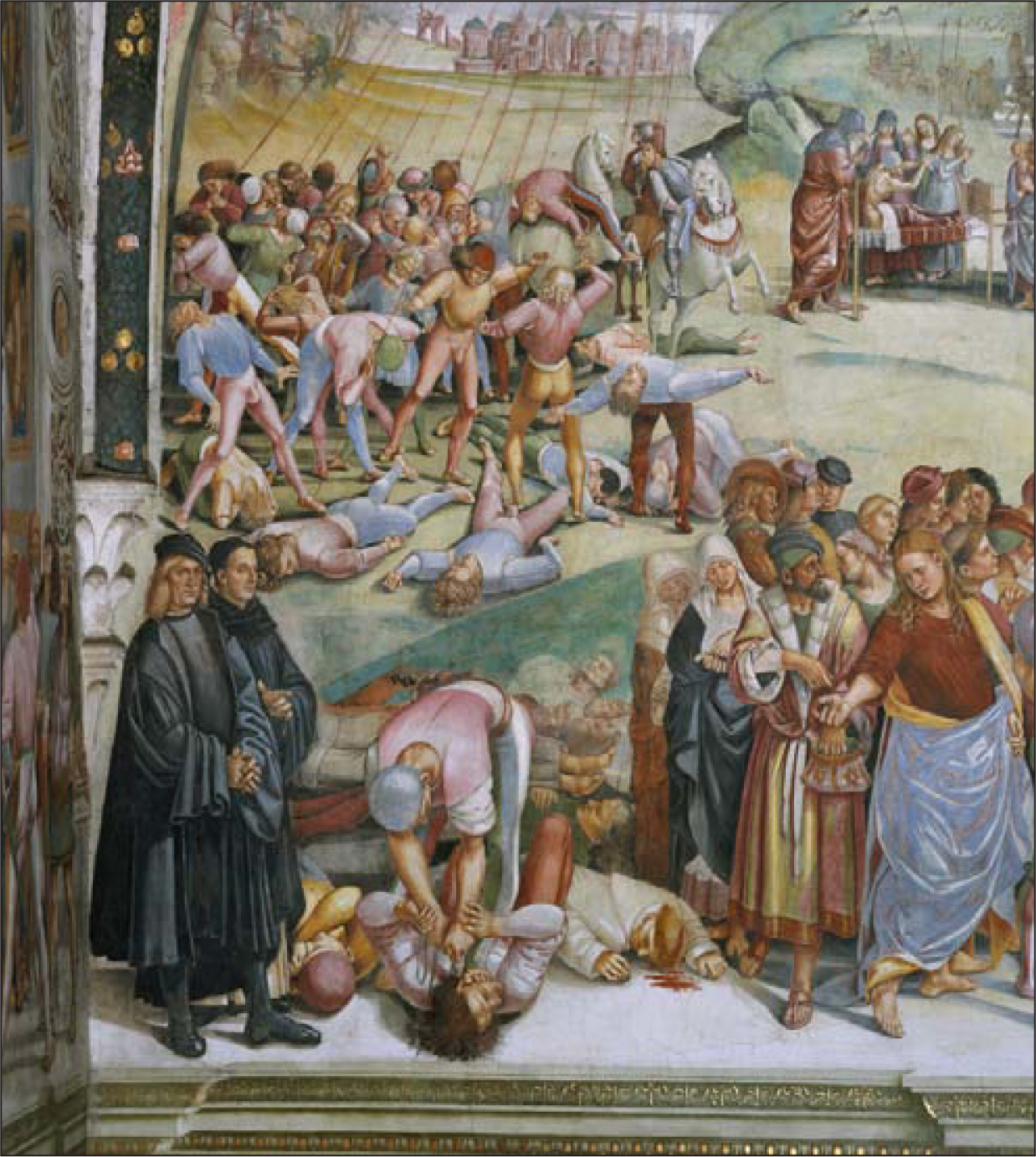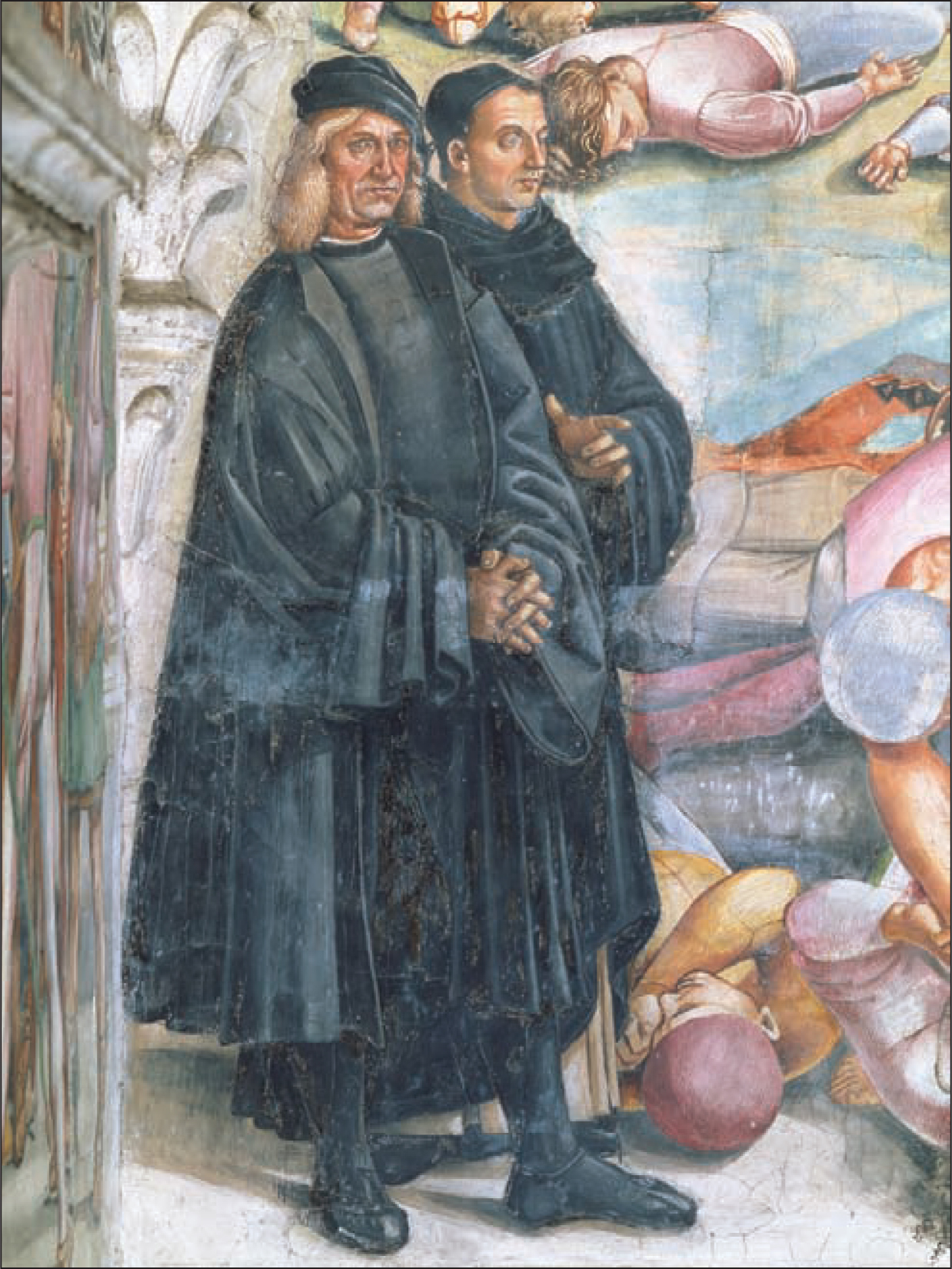![]()
WHAT RICHARD AND MARIETTA SAY ABOUT ALL THIS
![]()
AFTER THE SCINTILLATING START OF THEIR ARTICLE, when the Karpes go on to discuss Signorelli’s life and art, they suddenly write as if for a high school term paper. Mainly, they quote from the Encyclopaedia Britannica and an art historian named Maud Cruttwell—apparently their only sources for seeing and understanding the frescoes. But their summation in their own words clearly states the main point: “Signorelli was the first to succeed in depicting the nude human body in action. He was especially successful in depicting fiends, demons, angels and soldiers. . . . Signorelli emphasized nakedness, grouping and movement, but also an additional element: Aggression. Aggression is expressed so vividly that it arouses anxiety in the spectator.”
If only they had seen the art firsthand! Surely they would have recognized that Signorelli’s frescoes also have a fantastic allure because of how they are painted. Their visual attributes are in a different realm from their subject matter, even if their painterly virtuosity is responsible for the subject matter’s being so moving, and I wish that Richard and Marietta could have witnessed this. When we compare the Cappella Nova frescoes to other fresco cycles to which art lovers make pilgrimages in central Italy, they stand apart.
For me, absolutely nothing is as beautiful, as serene, as elegant and seductive as Piero della Francesca’s frescoes in Arezzo, not so far from Orvieto. They intoxicate the way that Beethoven’s late chamber music does. Yet when you face the Signorellis, it is as if they are life and blood, while Piero’s are so delicate and ethereal that they seem to have the limitations of a fantasy. The Signorellis are the embodiment of life’s truths, harsh though they may be. Giotto’s frescoes in Padua have phenomenal formal qualities, and a religious beauty that can convince even the most committed skeptic that the flight into Egypt and the adoration of the magi must have taken place just as they are shown here—with the mountain peaks echoing the donkey’s form, and the golds and pinks and powdery blues becoming in our imagination the actual colors of the biblical events—but, yet again, when we see the Signorellis, these marvelous paintings by Giotto that are sublime as delicious diversions seem less valid as conveyors of the truth. The Giottos and Pieros have unequaled beauty, but they are not as robust or visceral.
There are many knowing art historians who would say, “But of course.” Giotto, after all, falls into the category of an “Italian Primitive.” Because of that same simplicity and relative lack of sophistication, Piero, until the early twentieth century, was not nearly as highly regarded as he has become now that we view art with eyes trained by Modernism. It is the painters of the High Renaissance, most particularly the ones who followed Signorelli by a few years—Michelangelo, Leonardo, and Raphael—who were, in earlier times, considered the great masters of painting, because of their advances beyond the Primitives. But today, in a world where taste has been universally re-formed because of the vision of Cézanne, followed by the impact of Matisse and Picasso, and then the elegant simplification of the Bauhaus masters and Mondrian, most art enthusiasts, myself included, know the Pieros and the Giottos far better than the work of the later Italians, especially a relatively minor one like Signorelli. This is a further reason that the impact of the Cappella Nova (which I would not have bothered to see were it not for Freud) is so surprising.
EVEN IF THE KARPES DID NOT GET TO THE ACTUAL SCENE, and do not venture into the territory of Freud’s intense responsiveness to other Italian paintings—the intimate way he was moved by art and described it to Martha—when they tell us that, on September 22, 1898, Freud wrote Fliess, declaring the Signorellis “the finest I have seen,” it is an extraordinary revelation. Richard and Marietta, perhaps, did not recognize just how unusual that assessment was. There may be no other art lover in history who has rated Luca Signorelli’s work above all other paintings.
The vast majority of enthusiasts opt for the Michelangelos in the Sistine Chapel or the Raphaels in Florence. A smaller group shares my preference for the Piero della Francescas in Arezzo or the Giottos in Padua. Certain very knowing viewers—Balthus, for example, and his savvy, mysterious wife, Setsuko—put Mantegna’s more-real-than-real frescoes in Mantua at the top of the list (although Balthus, if forced to make the choice, rated Piero even higher, preferring the ungraspable to the palpable). For Josef Albers, tellingly, the number one was Duccio—for Duccio’s lively, anxious outlines, and the luminous, jewel-like coloring and knowing articulation that make the linear tension stimulating as opposed to threatening. Those who want to get to the origins of verisimilitude in art, and the ability to convey mass and weight, opt for Masaccio’s Bramante Chapel, in Florence. Lovers of the picturesque go for the Carpaccios in San Giorgio degli Schiavone, in Venice. I personally am moved to ecstasy, even more than I anticipate, every time I go to see either of these two groups of paintings and the Mantegnas. Aficionados of the robust, meanwhile, would probably cite one or another group of Tintorettos.
Freud, I think, is unique in labeling the Signorellis “the finest.” He does so with rare modesty. He says “I have ever seen.” He is never as humble or insouciant as an analyst of human beings; I am enchanted by the freshness and modesty he evinces in response to the Italian master.
Freud, who knew his Italian art, had to have been aware of all the painting groups to which I refer—from their reproductions in books, if not from actual visits. That the man who chose his words so carefully wrote Fliess—a confessor figure, to whom there would have been no shambling about the truth—that Signorelli’s paintings in Orvieto were, bar none, “the finest I have ever seen” is a fact of inestimable significance.
From that vital statement, we get to yet another nugget of information from the Karpes. They quote a footnote from The Psychopathology of Everyday Life. How like these scholarly Viennese friends of my parents to have fastened onto a detail relegated to the footnotes, unlike the rest of Mother and Dad’s chosen companions, who barely made it through articles in Life magazine. The Karpes’ chosen detail is where Freud reveals “that during the time while he could not recall the painter’s name, he saw the frescoes and Signorelli’s self-portrait ultra-clearly in his mind. The visual memory faded when he was told the forgotten name.”

Plate 6: Detail of Deeds of the Antichrist
The matter of the self-portrait is of particular interest. Sigmund Freud has revealed something extraordinary about his own mental process. He could readily envision the physical image of a fifteenth-century painter, while he was unable to conjure the name of the man whose self-portrait it was, but he could no longer see the person once he identified him with the name that began with the same first three letters of his own. The Karpes, via Maud Cruttwell, identify the Signorelli self-portrait as being one of the two figures on the left-hand side of Deeds of the Antichrist.
HE IS A HANDSOME BUCK WITH LONG BLOND TRESSES, a strong jaw, and prizefighter’s features. This tall, beefy character stares at us with a look of certainty; he has wise eyes, and, while taciturn, betrays intense feeling. [plate 7] His face is fleshy, his skin ruddy and weathered, with the lines of someone who has lived a lot of his life outdoors. He has a classic sort of Italian nose—a mix of Robert de Niro’s and Sylvester Stallone’s—as if he has possibly broken it under another man’s jabbing left hook. His long, thick golden hair gives him a certain wildness. But he is dressed in a proper black tunic and cloak, and, unlike his subjects, shows little of his body, except for his enormous hands, of which the long, thick fingers are interlocked with a mighty grip. His feet, in black shoes, are absolutely enormous, and even if their tremendous scale can be attributed to foreshortening because of the angle at which we see him, they are still, proportionately, like the feet of a Giacometti sculpture of an upright man: a massive, solid base for standing tall and proud, firmly positioned on earth, as assured physically as emotionally.

Plate 7. Detail of Deeds of The Antichrist
Luca Signorelli had used his corporeal self to “sign” his work. Yes—“sign!”—another word or name with the letters s, i, g, and n. That is in English but the German is “die Signatur,” although it is also “die Unterschrift.” It is with his own face and torso that he identifies himself as the author of his artwork. For Freud, by contrast, written and verbal language, names for things and people, were the vehicles of human thought. He gave them a preeminent role. What is astonishing is that once he had Signorelli’s name back in his mind, he completely eradicated from his mind the image of the man as flesh and blood. It is as if the language of identification allowed him to escape from something that troubled him so much that he could not think about it: the man as a physical being. I find that form of parapraxis even more astonishing than the blocking of the name.
The Karpes point out that “Signorelli left his signature on that painting in the form of his self-portrait. Did Freud see his own self-portrait somewhere in this painting which made such a strong impression on him? Who is Anti-Christ for Signorelli? Who is Anti-Christ for Freud?” These are interesting thoughts, but how about the idea that, for Sigmund Freud, the name for someone mattered so much more, and was so much safer, that once he again fastened his mind on it, he obliterated the man’s actual physical presence?
We will need to delve further into the Karpes’ questions about these relationships to the Antichrist, since they inform us that this shady character, central to one of the frescoes, was a stand-in for Jews. Shown with the devil whispering in his ear, he also represented the church hierarchy that commissioned Signorelli. Being Jewish and having the money to pay for something were, in Freud’s world, connected—and like the movement of a matador’s red muleta to a bull.
I HAVE TO ADMIT THAT IN MY FIRST VIEWING of the frescoes, the iconographical details explained by the Karpes were lost on me. Initially, I did not understand the symbolism of what I was looking at. It was only Richard and Marietta’s explication that opened my eyes to the role of the Antichrist in the frescoes, and to the effect of his representation on various viewers. But once the Karpes caused me to consider how Freud, as a Jew, would have reacted to a portrayal of the quintessential Jew as an opponent of Christian goodness, I found these paintings even more provocative than I had to begin with. How could the painter dare to represent his patrons in the form of a traitor in concert with the devil?
The painter’s self-portrait also begs another major question: What is it to see and understand a world while keeping apart from it? This is how Signorelli presents his own role. Did Freud identify with Signorelli in that capacity, and hate something about their shared role, as savvy observer of human frailties, that caused him to forget the name that resembled his own? Moreover, in spite of the one moment in front of his children when he stood up to anti-Semitism, was there not a side of him that often observed the denigration of Jews while remaining mute? Was he not also anti-Semitic, causing him to survey certain horrors, as Signorelli did, without taking action? Was he plagued by his own guilt?